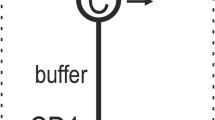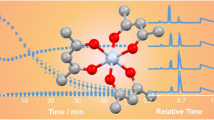Abstract
Although microchip electrophoresis (MCE) is intended to provide reliable quantitative data, so far there is only limited attention paid to these important aspects. This study gives a general overview of key aspects to be followed to reach high-precise determination using isotachophoresis (ITP) on the microchip with conductivity detection. From the application point of view, the procedure for the determination of acetate, a main component in the pharmaceutical preparation buserelin acetate, was developed. Our results document that run-to-run fluctuations in the sample injection volume limit the reproducibility of quantitation based on the external calibration. The use of a suitable internal standard (succinate in this study) improved the repeatability of the precision of acetate determination from six to eight times. The robustness of the procedure was studied in terms of impact of fluctuations in various experimental parameters (driving current, concentration of the leading ions, pH of the leading electrolyte and buffer impurities) on the precision of the ITP determination. The use of computer simulation programs provided means to assess the ITP experiments using well-defined theoretical models. A long-term validity of the calibration curves on two microchips and two MCE equipments was verified. This favors ITP over other microchip electrophoresis techniques, when chip-to-chip or equipment-to-equipment transfer of the analytical method is required. The recovery values in the range of 98–101 % indicate very accurate determination of acetate in buserelin acetate, which is used in the treatment of hormone-dependent tumors. This study showed that microchip ITP is suitable for reliable determination of main components in pharmaceutical preparations.


Similar content being viewed by others
References
Orr JD, Krull IS, Swartz ME. Validation of impurity methods, part I. LC GC North America. 2003;21(7):626-33
Liu X, Tracy M, Pohl C. A platform method for pharmaceutical counterion analysis by HPLC. Poster Note 20948 from HPLC 2014. http://www.thermoscientific.com/content/dam/tfs/ATG/CMD/CMD%20Documents/posters/PN-20948-Pharmaceutical-Counterion-Analysis-HPLC-2014-PN20948-EN.pdf. Assessed 15 Apr 2016.
Paulekuhn GS, Dressman JB, Saal C. Trends in active pharmaceutical ingredient salt selection based on analysis of the orange book database. J Med Chem. 2007;50(26):6665–72.
Štěpánová S, Kašička V. Determination of impurities and counterions of pharmaceuticals by capillary electromigration methods. J Sep Sci. 2014;37(15):2039–55.
Kler PA, Sydes D, Huhn C. Column-coupling strategies for multidimensional electrophoretic separation techniques. Anal Bioanal Chem. 2015;407(1):119–38.
Suntornsuk L. Recent advances of capillary electrophoresis in pharmaceutical analysis. Anal Bioanal Chem. 2010;398(1):29–52.
Tamizi E, Jouyban A. The potential of the capillary electrophoresis techniques for quality control of biopharmaceuticals—a review. Electrophoresis. 2015;36(6):831–58.
Manz A, Harrison DJ, Verpoorte EMJ, Fettinger J, Paulus A, Lüdi H, et al. Planar chips technology for miniaturization and integration of separation techniques into monitoring systems. Capillary electrophoresis on a chip. J Chromatogr A. 1992;593(1-2):253–8.
Castro ER, Manz A. Present state of microchip electrophoresis: state of the art and routine applications. J Chromatogr A. 2015;1382:66–85.
Nuchtavorn N, Suntornsuk W, Lunte SM, Suntornsuk L. Recent applications of microchip electrophoresis to biomedical analysis. J Pharm Biomed Anal. 2015;113:72–96.
Ou G, Feng X, Du W, Liu X, Liu BF. Recent advances in microchip electrophoresis for amino acid analysis. Anal Bioanal Chem. 2013;405(25):7907–18.
Tetala KKR, Vijayalakshmi MA. A review on recent developments for biomolecule separation at analytical scale using microfluidic devices. Anal Chim Acta. 2016;906:7–21.
Chen L, Prest JE, Fielden PR, Goddard NJ, Manz A, Day PJR. Miniaturised isotachophoresis analysis. Lab Chip Miniaturisation Chem Biol. 2006;6(4):474–87.
Revermann T, Götz S, Künnemeyer J, Karst U. Quantitative analysis by microchip capillary electrophoresis—current limitations and problem-solving strategies. Analyst. 2008;133(2):167–74.
Bidulock ACE, van den Berg A, Eijkel JCT. Improving chip-to-chip precision in disposable microchip capillary electrophoresis devices with internal standards. Electrophoresis. 2015;36(6):875–83.
Rudašová M, Masár M. Precise determination of N-acetylcysteine in pharmaceuticals by microchip electrophoresis. J Sep Sci. 2016;39(2):433–9.
Westermeier R. Isotachophoresis. In: Electrophoresis in practice: a guide to methods and applications of DNA and protein separations (4th edition). Weinheim: Wiley-VCH; 2016. pp. 45-9
Sádecká J, Masár M. Electrophoresis | capillary isotachophoresis. In: Reedijk J, editor. Elsevier reference module in chemistry, molecular sciences and chemical engineering. Waltham: Elsevier; 2014. p. 1–9.
Boček P. Analytical isotachophoresis. In: Analytical problems (Topics in Current Chemistry 95). Berlin: Springer; 1981. p. 131–77.
Gebauer P, Malá Z, Boček P. Recent progress in analytical capillary ITP. Electrophoresis. 2009;30(1):29–35.
Millar RP, Lu ZL, Pawson AJ, Flanagan CA, Morgan K, Maudsley SR. Gonadotropin-releasing hormone receptors. Endocr Rev. 2004;25(2):235–75.
Limonta P, Marelli MM, Mai S, Motta M, Martini L, Moretti RM. GnRH receptors in cancer: from cell biology to novel targeted therapeutic strategies. Endocr Rev. 2012;33(5):784–811.
Sanz-Nebot V, Benavente F, Toro I, Barbosa J. Evaluation of chromatographic versus electrophoretic behaviour of a series of therapeutical peptide hormones. J Chromatogr A. 2003;985(1-2):411–23.
Lodén H, Amini A. Quantification of buserelin in a pharmaceutical product by multiple-injection CZE. Electrophoresis. 2007;28(10):1548–56.
Staňová A, Marák J, Rezeli M, Páger C, Kilár F, Kaniansky D. Analysis of therapeutic peptides in human urine by combination of capillary zone electrophoresis-electrospray mass spectrometry with preparative capillary isotachophoresis sample pretreatment. J Chromatogr A. 2011;1218(48):8701–7.
Staňová A, Marák J, Maier V, Ranc V, Znaleziona J, Ševčík J, et al. Analysis of buserelin in urine by online combination of capillary zone electrophoresis with electrospray mass spectrometry. Electrophoresis. 2010;31(7):1234–40.
Sanz-Nebot V, Benavente F, Balaguer E, Barbosa J. Capillary electrophoresis coupled to time of flight-mass spectrometry of therapeutic peptide hormones. Electrophoresis. 2003;24(5):883–91.
Wätzig H, Degenhardt M. Characterisation of buserelin acetate by capillary electrophoresis. J Chromatogr A. 1998;817(1-2):239–52.
Wiliams RC, Boucher R, Brown J, Scull JR, Walker J, Paolini D. Analysis of acetate counter ion and inorganic impurities in pharmaceutical drug substances by capillary ion electrophoresis with conductivity detection. J Pharm Biomed Anal. 1997;16(3):469–79.
Zhou L, Dovletoglou A. Practical capillary electrophoresis method for the quantitation of the acetate counter-ion in a novel antifungal lipopeptide. J Chromatogr A. 1997;763(1-2):279–84.
Ridge S, Hettiarachchi K. Peptide purity and counter ion determination of bradykinin by high-performance liquid chromatography and capillary electrophoresis. J Chromatogr A. 1998;817(1-2):215–22.
Sázelová P, Kašička V, Šolínová V, Koval D. Determination of purity degree and counter-ion content in lecirelin by capillary zone electrophoresis and capillary isotachophoresis. J Chromatogr B Anal Technol Biomed Life Sci. 2006;841(1-2):145–51.
Kaniansky D, Masár M, Bielčíková J. Electroosmotic flow suppressing additives for capillary zone electrophoresis in a hydrodynamically closed separation system. J Chromatogr A. 1997;792(1-2):483–94.
Kaniansky D, Masár M, Bodor R, Žúborová M, Ölvecká M, Jöhnck M, et al. Electrophoretic separations on chips with hydrodynamically closed separation systems. Electrophoresis. 2003;24(12-13):2208–27.
Hruška V, Jaroš M, Gaš B. Simul 5—free dynamic simulator of electrophoresis. Electrophoresis. 2006;27(5-6):984–91.
Hirokawa T, Nishino M, Aoki N, Kiso Y, Sawamoto Y, Yagi T, et al. Table of isotachophoretic indices. I. Simulated qualitative and quantitative indices of 287 anionic substances in the range ph 3-10. J Chromatogr A. 1983;271(2):D1–106.
Grass B, Neyer A, Johnck M, Siepe D, Eisenbeiss F, Weber G, et al. A new PMMA-microchip device for isotachophoresis with integrated conductivity detector. Sensors Actuat B-Chem. 2001;72(3):249–58.
Acknowledgments
We greatly acknowledge the financial support of the Slovak Research and Development Agency (APVV-0259–12), and the Slovak Grant Agency for Science (VEGA 1/0340/15).
Author information
Authors and Affiliations
Corresponding author
Ethics declarations
Conflict of interest
The authors have declared that they have no conflict of interest.
Additional information
Published in the topical collection Fundamental Aspects of Electromigrative Separation Techniques with guest editors Carolin Huhn and Pablo A. Kler.
Electronic supplementary material
Below is the link to the electronic supplementary material.
ESM 1
(PDF 330 kb)
Rights and permissions
About this article
Cite this article
Hradski, J., Chorváthová, M.D., Bodor, R. et al. Quantitative aspects of microchip isotachophoresis for high precision determination of main components in pharmaceuticals. Anal Bioanal Chem 408, 8669–8679 (2016). https://doi.org/10.1007/s00216-016-9815-2
Received:
Revised:
Accepted:
Published:
Issue Date:
DOI: https://doi.org/10.1007/s00216-016-9815-2




